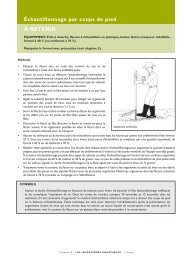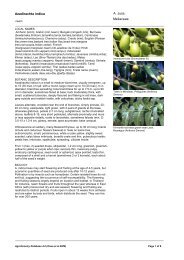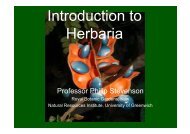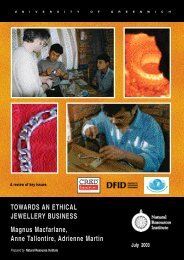botanical insecticides, deterrents, and repellents in modern ...
botanical insecticides, deterrents, and repellents in modern ...
botanical insecticides, deterrents, and repellents in modern ...
Create successful ePaper yourself
Turn your PDF publications into a flip-book with our unique Google optimized e-Paper software.
Annu. Rev. Entomol. 2006.51:45-66. Downloaded from arjournals.annualreviews.org<br />
by University of British Columbia Library on 12/09/05. For personal use only.<br />
56 ISMAN<br />
face the use of antifeedants <strong>in</strong> agriculture (47). The first is <strong>in</strong>terspecific variation<br />
<strong>in</strong> response—even closely related species can differ dramatically <strong>in</strong> behavioral<br />
responses to a substance—limit<strong>in</strong>g the range of pests affected by a particular antifeedant<br />
(43). Some substances that deter feed<strong>in</strong>g by one pest can even serve as<br />
attractants or stimulants for other pests. The second is the behavioral plasticity <strong>in</strong><br />
<strong>in</strong>sects—pests can rapidly habituate to feed<strong>in</strong>g <strong>deterrents</strong>, render<strong>in</strong>g them <strong>in</strong>effective<br />
<strong>in</strong> a matter of hours. This has been recently demonstrated not only for pure<br />
substances like azadiracht<strong>in</strong> (13), but also for complex mixtures (plant extracts)<br />
(1). Whereas a highly mobile (fly<strong>in</strong>g) <strong>in</strong>sect may leave a plant upon first encounter<strong>in</strong>g<br />
an antifeedant, a less mobile one (larva) may rema<strong>in</strong> on the plant long enough<br />
for the deterrent response to wane. Such behavioral changes are important <strong>in</strong> light<br />
of the observation that some plant substances are <strong>in</strong>itially feed<strong>in</strong>g <strong>deterrents</strong> but<br />
lack toxicity if <strong>in</strong>gested. Azadiracht<strong>in</strong> is clearly an exception to this rule, as <strong>in</strong>gestion<br />
leads to deleterious physiological consequences, but many other compounds<br />
or extracts with demonstrated antifeedant effects lack toxicity when adm<strong>in</strong>istered<br />
topically or via <strong>in</strong>jection (8, 9).<br />
Repellents<br />
For many chemists, an effective alternative to DEET (N,N-diethyl-m-toluamide)<br />
for personal protection aga<strong>in</strong>st mosquitoes <strong>and</strong> bit<strong>in</strong>g flies is the holy grail. In<br />
spite of five decades of research, no chemical has been found that provides the<br />
degree of protection aga<strong>in</strong>st bit<strong>in</strong>g mosquitoes or persistence on human sk<strong>in</strong> afforded<br />
by DEET (74). Concerns with the safety of DEET, especially to children,<br />
have resulted <strong>in</strong> the <strong>in</strong>troduction of several plant oils as natural alternatives. Some<br />
personal <strong>repellents</strong> <strong>in</strong> the U.S. marketplace conta<strong>in</strong> oils of citronella, eucalyptus,<br />
or cedarwood as active <strong>in</strong>gredients; 2-phenethylpropionate, a constituent of<br />
peanut oil, <strong>and</strong> p-menthane-3,8-diol (obta<strong>in</strong>ed from a particular species of m<strong>in</strong>t)<br />
(Figure 2) are also used <strong>in</strong> consumer products. All of these materials can provide<br />
some protection, but the duration of their effect can be limited (often











